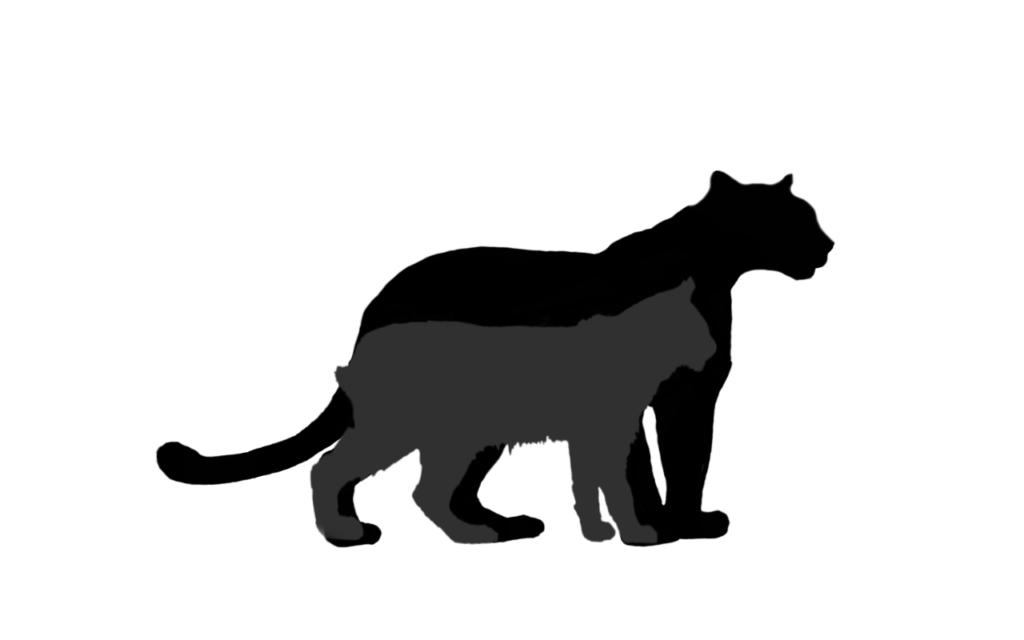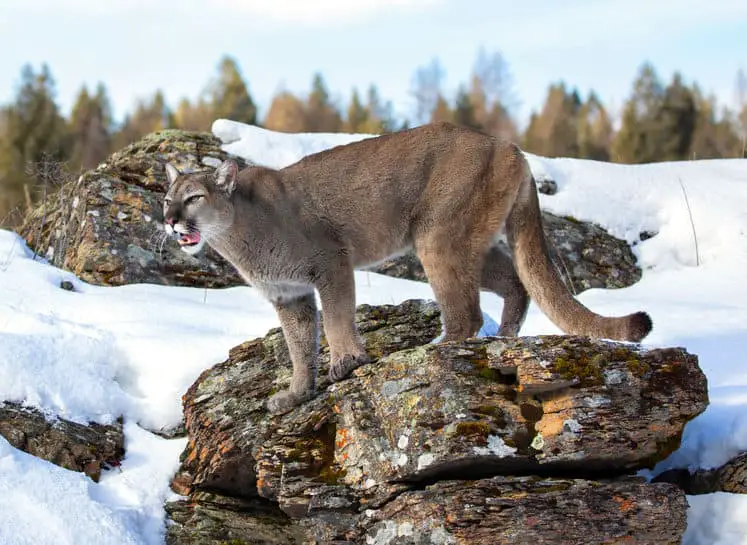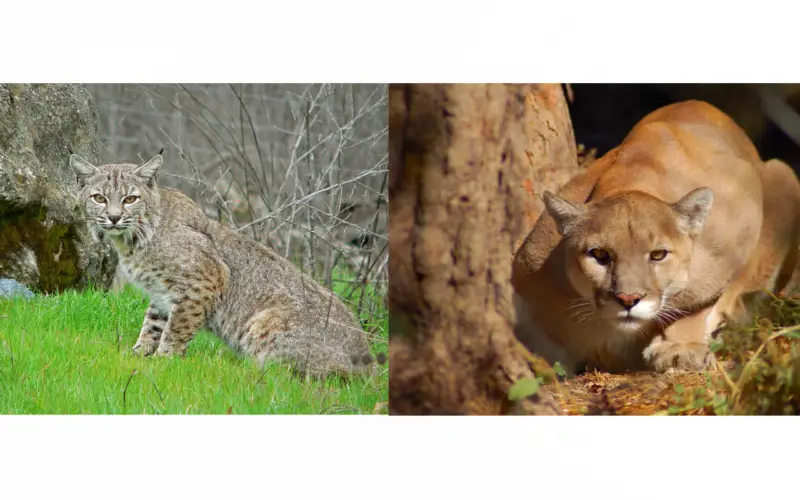Updated on 7/28/2023
Bobcats and mountain lions are both wildcats that are endemic to the Americas. Bobcats are native only to North America. On the other hand, the mountain lion is native to all three American continents, from Canada to the southern tip of South America.
An adult mountain lion is 4 to 5 times larger than an average adult bobcat. What’s more, bobcats have short. “bobbed” tails, while mountain lions have long tails. These two species of cat also have some differences in the color of their fur.
Given these phenotypical differences, it ought to be simple to distinguish between these two wild cats. However, people regularly mistake bobcats for mountain lions. See In the article below, we’ll look at some similarities and key differences between bobcats and mountain lions.
Bobcats And Mountain Lions Are Both Small Cats.
Bobcats and mountain lions are both scientifically classified as small cats. The reason for this is that they both lack the ability to roar while on the other hand, they both have the ability to purr. Read below to find out more detail.
There are about forty different species of wild cats in the world. Some are classified as big cats, and others as small cats.
The distinguishing feature that big cats have, and small cats don’t is the ability to roar. Small cats have ossified hyoid bones. This prevents them from roaring. Neither the bobcat nor the mountain lion have the ability to roar. Consequently, they are both classified as small cats. This ossification of the hyoid apparatus gives small cats the ability to purr.
Some examples of big cats are African lions and tigers. These big felines can roar but can’t purr. Therefore, they belong to the ” big cat ” group.
On the other hand, neither the bobcat nor the mountain lion have the ability to roar. What’s more, both of these feline predators purr. Consequently, they are both classified as small cats.
Common And Scientific Names For Bobcat vs Mountain Lion
Bobcats
Bobcats are sometimes referred to as red lynx. Their scientific name is Lynx Rufus. Originally, there were 13 identified bobcat subspecies. In 2017 scientists narrowed those 13 down to 2 sub-species. They are Lynx Rufus Rufus which lives from the great plains east, and Lynx Rufus Fasciatus, which lives west of the great plains.
Mountain Lions
Due in part to the wide geographical area that they inhabit, the mountain lion is referred to by many names. It holds the Guinness world record for the animal with the greatest number of terms. Some of the more commonly used ones are mountain lion, puma, cougar, catamount, and panther.
The mountain lion or cougar was originally given the taxonomic designation of Felis Concolor. This placed them in the same genus as the house cat. In 1973 they were moved into their own “Puma” genus. Today their scientific name is Puma Concolor.
Historically, there were as many as 32 recorded subspecies of mountain lions. However, as of 2017, modern DNA analysis supports the existence of only 2. The first one is the Puma concolor cougar which inhabits North America, Central America, and possibly northern South America. The second one is Puma concolor concolor which inhabits only South America.

Physical Characteristics of Bobcats Vs Mountain Lions
The main difference between bobcats and mountain lions is their size. Bobcats have a much smaller size at maturity than do mountain lions.
Additionally, bobcats have short tails as opposed to a mountain lion’s long one.
Bobcats also have mottled black or dark brown spots on top of a tan or grey coat, whereas a mountain lion’s coat is mainly dark tan.
Bobcats
An average adult bobcat is about twice the size of a domestic cat. They are 2 to 4 feet long and weigh 15 to 35 pounds. This is much smaller than an average mountain lion. Their fur is usually gray to brown with mottled dark spots that range from black to dark brown on their bodies and dark bars on their inner forelegs and tail. They have small tufts of black hair at the tips of their pointed ears that are black at the tips.
They also have a whiskered face that seems broader due to the extended length of their facial hair and whiskers. Their eyes tend to be yellow with vertically shaped, black pupils. A bobcat also has a “bobbed” short tail with a black tip. There are documented cases in both Canada and the United States of Melanistic or black-shaded bobcats. These animals still have mottled black spots over the top of their dark coat.
For hunting, bobcats have a mouthful of sharp teeth and four sharp retractable claws on each foot.
Mountain Lions
An adult mountain lion is up to eight feet long from its nose to the tip of its tail and weighs 75 to 220 pounds. The heaviest cougar ever documented weighed in at 276 pounds. This big feline has a slender body with a round head and round, erect ears. They look a lot like giant domestic cats.
The hair coat of a mountain lion is usually yellowish-brown. The area above their upper lip, below their lower lip, and their chin are all white. They also may have a sprinkling of black hair on their backs. A mountain lion has a long tail. Their cylindrical tail is two and a half to three feet long and has a dark brown tip.
Like bobcats, mountain lions have retractable sharp claws and a mouthful of sharp teeth. These large cats also have a very powerful bite. When they kill larger animals such as deer, they leap on the animal’s back and either kill the animal by suffocation by crushing its trachea, or they bite through its spinal column at the base of its skull.
Range and Habitat
Bobcats
Bobcats can live in deciduous or coniferous woodland, swampland, or semi-desert environment. They prefer low human population density areas. However, they’re adaptable and can live in surprisingly close proximity to human settlements as long as they have sufficient food sources and cover.
In Mexico, the states of Veracruz and Oaxaca are the southern boundary of the bobcat’s range. They also live in the states of Guerrero, Michoacan, Jalisco Puebla, Tlaxcala, Morelos, Tamaulipas, Hidalgo, San Luis Potosi, Nuevo León, Nayarit, Durango, Sinaloa, Sonora Baja California, and Baja California Sur.
In the United States, bobcats range to some extent in all 48 contiguous states. They even make an occasional appearance in the District of Columbia. However, even though they are adaptable to urban areas and semi-urban areas, they do best in areas with sparse human population.
Bobcats range north through the United States and into the southern half of Canada. The snow depth in northern Canada is a limiting factor for bobcat range. Unlike their cousins, the Canadian Lynx, they do not do well in deep snow. The Lynx has oversized feet that act like snowshoes to allow it to walk on top of the snow. On the other hand, Bobcats lack the Lynx’s oversized feet, and consequently, moving through deep snow is more of a problem for them.
Mountain Lions
Mountain Lions, like Bobcats, commonly live in deciduous/evergreen woodland environments. They also live in steep rocky semi-desert habitats. Mountain lions are large animals and have the ability to take down large prey.
Although they also take down small prey, their primary prey is deer in large sections of their range in North America, so they live wherever the deer do. In areas with deep winter snow, they migrate with the deer herds from summer to winter ranges. Cougars account for around 18 pounds of biomass and consume around 10 pounds of meat per day. To do this, they need to kill a large ungulate animal or its equivalent in small animals almost once a week. See
They range from the Canadian Yukon to the southernmost tip of South America, where they’re called pumas.
Within the United States and Canada, mountain lions mainly live in the western states and provinces. They have mostly been expatriated from the eastern united states due to habitat loss. There is, however, an isolated population in Florida. The Florida panther lives in the southwestern portion of the sunshine state.
Traits and Behaviors
Bobcats
Bobcats are mainly nocturnal. What’s more, except during mating or when raising young, they are solitary animals and operate in home ranges that they patrol and scent mark with urine and feces.
These cats are good tree climbers and swimmers when they need to be.
They are generally secretive and silent. However, if they perceive that they’re threatened or cornered, they spit, hiss, and growl like the meanest, toughest house cats you’ve ever seen but on steroids. They’re not bluffing either.
Bobcats breed from winter to spring, and their gestation takes about two months. A bobcat litter will contain from one to six kittens. Female bobcats bring up the kittens in concealed burrows. Their young stay with their mother for nine to twelve months before striking out on their own.
Bobcats are carnivores and have characteristically sharp hearing and keen eyesight that they utilize in hunting. They rely the least on their sense of smell.
Despite their comparatively small size, bobcats are aggressive, tough predators. At times they prey on animals as large as adult deer. However, their regular diets mainly consist of smaller prey such as small mammals, reptiles, birds, and carrion. A bobcat has an average life span of 10-12 years.

Mountain Lions
Like a bobcat, a mountain lion is a nocturnal and solitary animal that is also very territorial.
Except for in the case of mating or raising their young, a mountain lion lives a solitary life. They cover a lot of country. An adult male’s home range is normally more than 100 square miles and up to 250 square miles. They sometimes mark their territories by leaving claw marks on trees. They also scratch up piles of leaves and or pine needles that they urinate on as scent markers. Male mountain lions fight to the death sometimes to defend their territory. See
Cougars have young at any time since they do not have a fixed mating season. The Gestation for these cats takes about three months. Mountain lion litters range from one to six cubs.
Female mountain lions have the active responsibility of taking care of their young ones and are very protective. Mountain lion cubs stay with their mothers anywhere from fifteen to twenty-six months.
Like bobcat’s mountain lions are generally silent and stealthy. They do vocalize, though. They snarl, hiss, and spit when the occasion demands it. Additionally, sometimes they’ll make a chirping noise that sounds a lot like a bird. A female mountain lion in estrus screams. This noise sounds a lot like the scream of a woman.
The mountain lion is an apex predator. In fact, they are one of the most powerful predatory cats in the world. When hunting, they use both strength and stealth. They can kill larger prey than themselves and have the ability to leap for 20 feet or more. The diet of a mountain lion mostly consists of deer, but they also prey on elk, moose, feral horses, and smaller animals such as raccoons, coyotes, squirrels, jackrabbits, and porcupines. In South America, they prey on llama-like animals called guanacos. They have jaws strong enough to bite through the shells of adult desert tortoises. This is an impossible feat for other predators.
Currently, the population of mountain lions is sustainable, and managed sport hunting is still legal in 13 U.S. states and 3 Canadian provinces. It’s also legal to hunt cougars in parts of Mexico and Argentina.
The average lifespan of a mountain lion in the wild is eight to thirteen years.
Are bobcats and mountain lions dangerous to pets and humans?
Bobcats will kill and eat your cat or small dog if the opportunity presents itself. Ordinarily, they don’t attack people unless they feel cornered or are rabid. If a bobcat attacks you, and you have the means to do so, try to kill it so that it can be tested for rabies; otherwise, you’ll automatically need to go through a series of painful but lifesaving rabies shots. It’s common sense, but when I say,” if you have the means to do so,” I mean if you have quick access to a gun.
Mountain lions are a different story. These cats mainly prey on wild animals. However, they have historically eaten many domestic animals, including domestic dogs, sheep, goats, cattle, and horses.
Mountain lion attacks on people are a rarity, but don’t let that make you complacent. They are large, formidable predators. In the last 100 years, there have been twenty-seven documented cases of mountain lions killing human beings.
As more people venture into mountain lion territory, the potential for human/mountain lion encounters increases. On rare occasions, mountain lions will stalk people. This is an extremely rare situation, but it does happen. Read another one of my articles, “Are Mountain Lions Dangerous?” to see what to do if it happens to you. Mainly, if you are unlucky enough to be attacked, fight back. There are many documented cases of humans successfully fending off mountain lion attacks with whatever weapon that happens to be available or even with their bare hands.
Summary
- They’re both small cats– Both bobcats and mountain lions are classified as small cats because they lack the ability to roar.
- Common and scientific names– Another common name for bobcats is red lynx. Their scientific name is Lynx Rufus. Other common names for mountain lions are puma, cougar, catamount, and panther. The scientific name for mountain lion is Puma Concolor.
- Physical characteristics– Bobcats are much smaller than mountain lions. They weigh 15 to 35 pounds and are 2 to 4 feet long. In color, bobcats are tan with dark brown to black spots. They also have a bobbed tail. On the other hand, Mountain lions are the 4th largest wild cat species in the world. They are up to 8 feet long from their nose to the tip of their tail and weigh up to 220 pounds. They have a yellow-brown coat, and they have a long cylindrical tail with a dark brown tip.
- Range and habitat– Bobcats live in woodland, semi-desert, and desert environments. They range from southern Canada on the northern end of their range to northern Mexico on the southern end. Mountain lions also live in woodland, semi-desert, and desert habitat. Their range goes through all 3 American continents. It begins in the Yukon territory in the north and goes to the Strait of Magellan in the south.
- Traits and behaviors-There is a chance that you might see one out and about at any time of day, but bobcats and mountain lions are both mainly nocturnal animals. Bobcats mainly prey on small mammals, birds, and reptiles but will occasionally kill deer. In North America, mountain lions mainly prey on deer, but they are opportunistic predators and will feed on whatever prey that is available, from moose to small rodents. The South American puma preys on guanacos.
- Danger to pets and humans– Both of these cats will readily prey on your pet if they get the opportunity. Except in the case of a rabid animal, bobcats are not a real threat to humans. On the other hand, mountain lions are physically capable of doing harm to a human being. Your chances of being bothered by a mountain lion are extremely rare. However, they are capable of and occasionally do attack people.
Recent Posts
The only venomous snakes in Washington State are Northern Pacific Rattlesnakes. The Northern Pacific Rattlesnake (Crotalus oreganus oreganus) is a sub-species of the Western Rattlesnake. Anyone...
Skunks are not classified as true hibernators. But they go into a state of torpor when the weather gets cold. Skunks are light sleep hibernators, along with opossums, bears, and raccoons. ...

